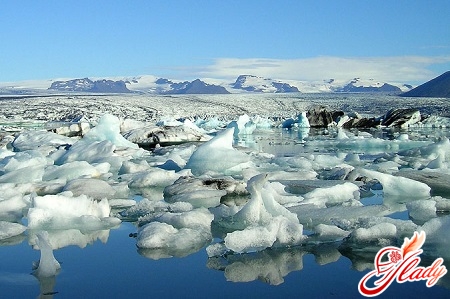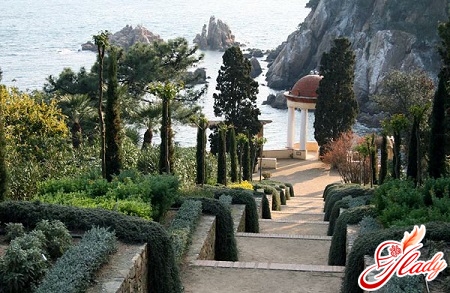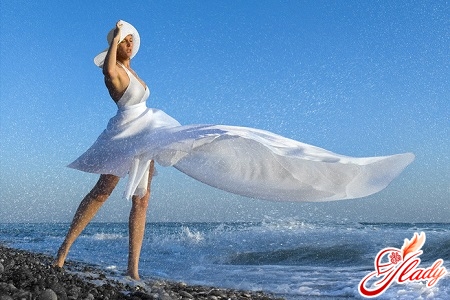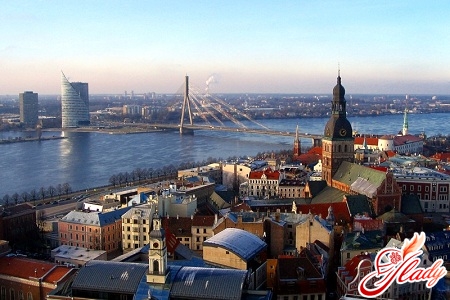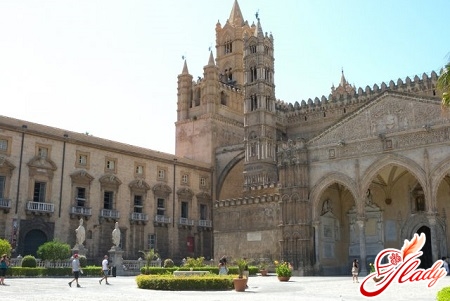
 Italy is an ancient country with a richhistory and culture. In addition, the European boot is also unusually colorful. Ancient buildings, centuries-old structures that make you literally freeze with delight, magnificent beaches, a mild climate, locals who are not at all greedy for emotions - all this and much more makes Italy attractive to tourists. But one name cannot unite all the diversity of original cultures, historical heritage and special charm of individual regions. And today our gaze is turned to the very south of Italy - the island of Sicily.
Italy is an ancient country with a richhistory and culture. In addition, the European boot is also unusually colorful. Ancient buildings, centuries-old structures that make you literally freeze with delight, magnificent beaches, a mild climate, locals who are not at all greedy for emotions - all this and much more makes Italy attractive to tourists. But one name cannot unite all the diversity of original cultures, historical heritage and special charm of individual regions. And today our gaze is turned to the very south of Italy - the island of Sicily.

A bit of the history of Sicily
Sicily is a kind of separatea country that is part of Italy. And it is not at all about its location separately from the mainland - after all, they are separated only by a narrow Strait of Messina, about 3 km wide. And it is not that the city of Palermo is home to the island's own parliament. But the fact is that Sicily has its own special historical path, leading it along a complex road of conquests and interpenetration of different cultures. Situated at the intersection of trade routes of the Mediterranean Sea, the island has had an important strategic significance since ancient times. Sicily was once part of Magna Graecia and was called Trinacria, which means triangle: 3 capes, 3 seas, 3 archipelagos. And the first inhabitants of the island are considered to be the Iberian tribes of the Sicans, who built pile houses. Their place was taken by the Sicules, and then the Phoenicians, who built Palermo and Trapani. Later, the Greeks founded such cities as Catania, Messina, Agrigento and Syracuse - one of the richest Greek settlements. The Sicilian lands, called "the key to the Mediterranean", were claimed by the barbarian tribes, the Byzantines, the Arabs and, of course, the Romans. The numerous inhabitants of these lands not only brought destruction, but also brought their customs, culture, architectural features to the appearance of the island, so now the abundance of monuments, museums, archaeological excavations makes the island of Sicily a unique and unlike any other region that is part of Italy. In addition, being the southernmost part of the country, it has a longer and more attractive tourist season for vacationers. The cleanest sandy beaches and the delightful greenery of citrus and olive groves make the island a real highlight and a tasty morsel for travelers.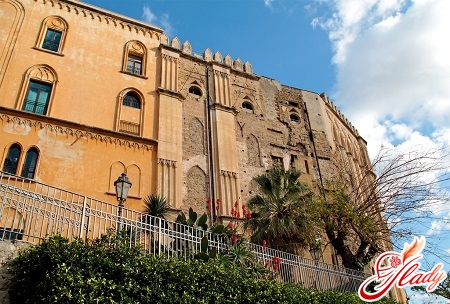


What to visit in Sicily
Sicily is the largest island inThe Mediterranean Sea. Its area is more than 25 thousand square kilometers. There are many large cities on this territory, so for the convenience of travelers, the sights of Sicily are usually divided by the cities near which they are located.

The Capital Region of Palermo
Palermo — capital of the island of Sicily.It is a large and ancient city founded by the Phoenicians and named by them Sousse, which translated means flower. Its modern name (in Latin it sounds like Panormos - "always accessible harbor") was received from the Greeks. The combination of different cultures that once resided in Palermo is extensive here, making the city's sights even more interesting.
Royal Norman Palace RoyalThe Norman Palace is the main architectural monument of Palermo, located in Liberty Square. The elevation on which it is built has historically been occupied by one or another bastion: initially, a Phoenician palace was built on this site, followed by a Roman one, and then an Arab one. The last of them, the Emir's Palace, was restored and turned into a royal residence by the Normans in the 11th-12th centuries. After 3 centuries of desolation, the palace was again rebuilt by the Spaniards for their monarchs. Now the original Norman interior has been preserved only in the Roger's Hall. This royal bedchamber offers a stunning view of the Palatine Chapel and the Gulf of Palermo.
Palatine Chapel Past suchIt is difficult to pass by such landmarks as the Palatine Chapel without being moved. Like many other monuments of Sicily, it combines various architectural styles. The Palatine Chapel was built in 1143 and is decorated with amazing Byzantine mosaics, surpassing the decoration of the churches of Constantinople. The image of Christ Pantocrator on the ceiling occupies a special place here.
Cathedral of the Assumption of the Virgin MaryThe grandeur of this landmark in Palermo is unmatched. On the site of its construction there were previously ancient religious sanctuaries. The Cathedral of the Assumption of Our Lady was built in 1185 during the reign of the Norman King William II. Over the course of its centuries-long history, the cathedral was restored many times, which somewhat changed its original appearance, adding Gothic features to it. Currently, the temple contains Norman royal sarcophagi and the remains of the patroness of Palermo - Santa Rosalia.
Admiral's Church (Martorana) Admiral'sThe church was built in the 12th century during the reign of King Roger II, using funds from Admiral G. of Antioch. In 1463, the basilica was transferred to the nearby Martorana Monastery. By combining these two names, the church received its name, which is still used today. Rare mosaics made by Constantinople artists are kept here.
The Grand Opera House Massimo Theatre building,Built in 1891, it was designed by the architect Giovanni Battista Filippo Basile. Neoclassicism was chosen as the main architectural style. The Teatro Massimo is the third largest theater in Europe, behind only the Parisian and Vienna theaters. Its area of 7,730 square meters can accommodate 3,500 spectators. The Grand Opera House of Sicily boasts performances by world celebrities such as Luciano Pavarotti, Enrico Caruso and Maria Callas. There is a legend about the mournful spirits that inhabit its halls around the Massimo, because there was once a church and an ancient cemetery on its site.
Archaeological Museum Archaeological MuseumThe island of Sicily is named after Antonio Salinas. An archaeologist and numismatist, he bequeathed 6,000 items from his collection to the museum, where he served as director for over 40 years. The archaeological museum is housed in a 17th-century building that once served an outlawed religious order, after which the confiscated building was transferred to the national museum.
Regional Gallery of Sicily RegionalThe gallery is located in the Abatellis Palace, built for the head of the port of Palermo in the 15th century. Later, there was a monastery here. In the middle of the last century, the building was heavily damaged by bombing during the war. And only in 1953, a gallery was opened in the restored building. Here you can find paintings by the Renaissance artist Antonello da Messina, admire a large fresco called "The Triumph of Death", and admire the works of Flemish painters. The gallery also has a sculpture exhibition, as well as ancient examples of works by virtuosos of wood carving from the 12th century.
Botanical Garden Botanical Garden of Palermo- This is not just an open-air reserve. It is a realization of the initially unconventional and original idea of combining a national park and a research center of the city university. The garden was created at the end of the 18th century and is located on a hill, which offers a wonderful view of the entire city. Several Sicilian architects who worked on the creation of the garden building decorated it with numerous sculptures, bas-reliefs and statues. On the territory of the botanical garden with an area of 10 hectares there was also room for an aquarium - a large pool with rare aquatic plants. The Maria Carolina greenhouse also occupies a special place here.
Orleans Ornithological Park OrleansThe park, located next to Independence Square, is home to 3,000 birds. It is home to one of Europe's largest collections of parrots, both well-known and rare. The park also features unearthly pink flamingos, graceful herons, colorful pheasants, pelicans, and serious birds of prey.
Villa Palagonia Villa Palagonia is located in15 km from Palermo, in the town of Bagheria. This place is mentioned in Goethe and Dumas, because this building is considered one of the most bizarre structures in Sicily. Designed by the architect Tommaso Maria Napoli, the villa is one of the first examples of Sicilian Baroque. Its other name is Villa of the Monsters. At the owner's whimsical request, the garden was decorated with grotesque sculptures of humanoid monsters, of which there are more than 600 pieces. But the oddities do not end there. Visitors to the villa in the 18th century noted the strange prickly fabric that covered the armchairs and sofas, the chair legs were of different lengths, and the lamps were glued together from shards of broken dishes.
The town of Corleone Some distance fromThe town of Corleone is located in Palermo. The "Godfather" of the Sicilian mafia from the novel by Mario Puzo firmly established certain associations with the island. However, in fact, the city of Corleone has nothing to do with the mafia, although it uses its fame to the delight of tourists. Colorful cafes, restaurants and shops exploit the mafia theme to the fullest. The city is also famous for its natural formations, excavations, towers and castles, rightfully considered one of the most interesting places for lovers of ecotourism and archeology.
Markets Vucciria and Pescheria If you want to seeFor a real Sicilian flavor, be sure to visit the local market. The traditional and atmospheric city market of Vucciria offers absolutely everything, while the Pescheria market specializes in fish and seafood.
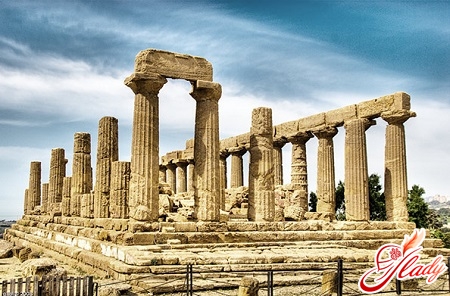


Province of Agrigento
Valley of the Temples Valley of the Temples is a zonearchaeological excavations, spread over an area of 13,000 hectares and is a UNESCO site that has no analogues among ancient Greek complexes. Here are grandiose buildings of the 6th-5th centuries BC, made in the Doric style. Among them, we can highlight the Temple of Concord, the Temple of Asclepius, the Temple of Hercules, the tomb of Theron, the Temple of Hera and others. These attractions, collected in one place, are the pearl of the excursion program of Agrigento. If you decide to take a trip to the Valley of the Temples on your own, then try to choose the best time: some of the shrines are open until 19-00, while others are open all night, illuminating the darkness with beautiful lighting.
Monastery of the Holy Spirit The monastery was built inThe end of the 13th century and was called Bataranni, which means "large abbey", for its impressive size. The building was constructed of sandstone and limestone with an original vaulted structure and a nave decorated with stucco. Today, this medieval monument, which has preserved its original appearance, serves as a city museum, where you can see a model of the city center of Agrigento.
Our Lady of Greece Church Like manyHistorical and cultural sites on the island of Sicily, the Greek Church of Our Lady was rebuilt from a Greek-Byzantine cathedral, which is largely reflected in the building's façade: it preserves 14th-century frescoes and the special Sicilian charm of the Gothic style.
Cathedral The cathedral was built in the 11th centuryin honor of St. Gerland. The temple was built at the highest point of Agrigento and over the centuries has been repeatedly destroyed by earthquakes and landslides. A striking example of the interpenetration of cultures, the cathedral simultaneously retains features of Gothic and Baroque, Arabic, Norman and Spanish architectural styles.
In addition to temples, monasteries and cathedrals in the Agrigento region, you can visit the archaeological museum, located on the site of a market square from ancient times.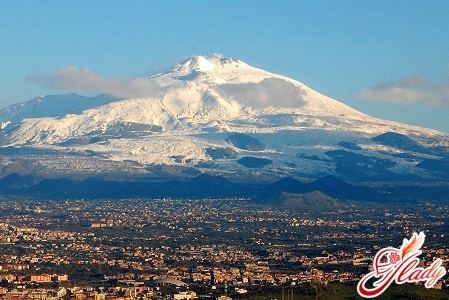


Province of Catania
Fountain with a black elephant Cathedral Square withThe fountain with the elephant made of black basalt is the calling card of the Catania region. On the elephant's back there is an Egyptian obelisk with a cross. The history of the origin of this emblem of the city is overgrown with legends, but it is known for certain that there are references to the black elephant in the chronicle dated 1239.
Cathedral of Saint Agatha Opposite the fountainwith a black elephant is the Cathedral of Saint Agatha, built on the site of the Baths of Aquiliana. In the 11th century, the temple was rebuilt in the Baroque style. The cathedral is decorated with frescoes and a sculptural bust of Saint Agatha. The ark with relics is also kept here. Also inside the temple is the tomb of Vincenzo Bellini - a composer born in Catania. There are other attractions in Catania: for example, you can visit the Ursino fortress, which currently houses the city museum, or the archaeological zone of the Roman amphitheater. In addition to architectural objects, a modern water park "Etnaland" has been built in Catania.
Volcano Etna The most important place to visitCatania, and the whole island of Sicily, is the volcano Etna. Such attractions, created by nature itself, always attract tourists from all over the world. Etna is the highest active volcano in Europe. The last recorded eruption was in January 2011, and throughout its history, Etna has erupted about 200 times. In ancient times, people associated the wrath of the volcano with the wars of Greek and Roman mythological creatures: gods and titans. Currently, the area around Etna is recognized as a national park. You can visit the volcano both with an excursion and independently along any of the 3 existing routes. However, be careful, because the volcano is only dormant, and there are semi-active craters on its slopes, so if you decide to climb it on foot, it is better to enlist the support of an experienced guide.


Province of Messina
Among the architectural and historical monuments inIn the Messina region you can visit the Church of Santa Maria Annunziata dei Catalani, the Duomo, the Fountain of Orion and the Fountain of Neptune, made by a student of Michelangelo, as well as the regional museum, which presents a rich collection of paintings. In the area of the city of Taormina, a special place is occupied by the Ancient Theater, the view from which is called the "panorama of perfection". In addition, you can visit Naumachia, the ruins of which give an idea of the staged water battles that took place there. Also worthy of attention are the Corvaja Palace, where the tourist information office is now located, and the Cathedral of San Nicolo, and the Badia Vecchia tower. Nature has created its own attractions: the picturesque capes of Capo Sant'Alessio, Capo Sant'Andrea and Capo Taormina.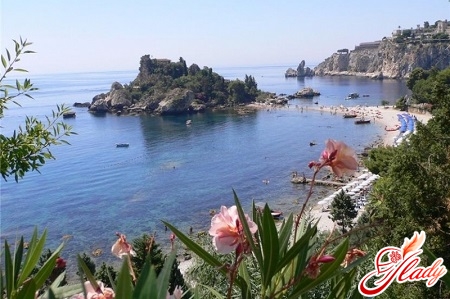


Province of Syracuse
The main object of inspection of Syracuse is acceptedconsidered an archaeological excavation area. It includes the Ear of Dionysius - a cleft in the rock with extraordinary acoustics; the Greek Theatre, which has survived to this day almost intact; and the Roman Amphitheater. In addition, the region has an archaeological museum and the Cathedral of Syracuse.

Province of Trapani
The main monument of the city is the sanctuaryVirgin Mary with a statue of Madonna and Child. The region also has its own city museum. The presence of a saltworks and a salt museum distinguish Trapani from all other regions of the island of Sicily. And do not forget to visit the town of Marsala - its charm and wineries will not leave you indifferent. Sicily is an extraordinary place, literally dotted with attractions, with a special flavor and unique nature. When traveling around the island, do not forget about hats, water, comfortable shoes and sunscreen. Una buona vacanza!
Comments
comments

Italy is an ancient country with a richhistory and culture. In addition, the European boot is also unusually colorful. Ancient buildings, centuries-old structures that make you literally freeze with delight, magnificent beaches, a mild climate, locals who are not at all greedy for emotions - all this and much more makes Italy attractive to tourists. But one name cannot unite all the diversity of original cultures, historical heritage and special charm of individual regions. And today our gaze is turned to the very south of Italy - the island of Sicily.









